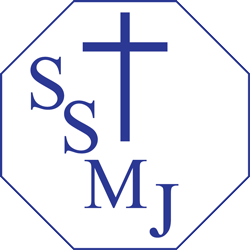As a school, we recognise that sound Literacy skills are essential for progress across all areas of the curriculum and to enable students to achieve their potential.
The impact of our English curriculum aims to ensure that pupils will leave SSMJ school:
- reading and writing with confidence, fluency and understanding, using a range of independent strategies to take responsibility for their own learning including self-monitoring and correcting their own errors;
- with a love of reading and a desire to read for both enjoyment and information;
- with an interest in words and their meanings; developing a growing vocabulary in relation to grammatical terminology;
- understanding a range of text types, media types and genres;
- able to write in a variety of styles and forms appropriate to the situation;
- using their developing creativity, imagination, inventiveness and critical awareness;
- having a suitable technical vocabulary to respectfully articulate their responses in any discussion.
The overarching intent of English in the National Curriculum is to promote high standards of Literacy, equipping pupils with a strong command of the written and spoken word and developing their love of literature through widespread reading for enjoyment.
All teachers at SSMJ have a responsibility to develop pupils’ competence in reading, writing and speaking and listening to ensure that pupils become competent users of language and can achieve their potential.
The development of literacy skills and knowledge will be implemented according to the following guidelines;
- Pupils will receive daily English lessons following National Curriculum guidelines.
- Staff will follow whole school policies on English and marking.
- Pupils highlighted as not making sufficient progress will be highlighted and receive appropriate intervention support as highlighted within the school provision map.
- Opportunities will be given across a broad and balanced curriculum to allow for opportunities to consolidate and reinforce taught literacy skills in all curriculum areas.
We use a variety of contexts for learning as appropriate;
- Whole-class/group shared and guided writing
- Whole-class/group reading skills lessons
- Phonics lessons
- Targeted intervention for children within sets and class-based groups.
Teaching approaches, whilst being referenced to the National Curriculum, are developed by individuals to suit their own classes’ needs and abilities. The following generic strategies are seen as particularly effective;
Sharing lesson objectives, success criteria, targets and outcomes with children during lessons.
- Demonstrating and modelling
- Explanation
- Questioning
- Discussion – (Talk partners, group activities)
- Taking roles, including “teacher in role”
- Encouraging review and editing through read and respond tasks and self-assessment and peer marking.
Our aim is to ensure that learners are engaged in their English lessons with activities that are:
- Interactive and interesting
- Appropriate and adapted according to ability/age related expectations
- Planned with purpose and audience in mind
- Varied and tightly timed and include opportunities for thinking and discussing.
- Planned and developed over a number of sessions, so that each genre is explored well and built upon progressively.
- Based around a whole ‘good quality’ text or visual literacy stimulus as well as model extracts.
English Documents
- English Curriculum Design pdf136.5 KbSep 17th, 2024
- English Curriculum Progression Map pdf138.2 KbSep 12th, 2023
- English policy pdf203.2 KbSep 17th, 2024
- English Terminology – Vocabulary Progression.docx.pdf pdf44.5 KbJun 17th, 2023
- English_Appendix_1 pdf286.4 KbSep 14th, 2023
- English_Appendix_2_-_Vocabulary_grammar_and_punctuation.pdf pdf323.2 KbJun 17th, 2023
- English_Glossary pdf397.1 KbSep 14th, 2023
- What does English look like at SSMJ? pdf114.4 KbSep 14th, 2023
If you would like more information about the curriculum please contact school where we will be happy to help.

